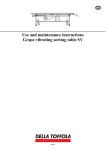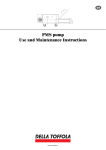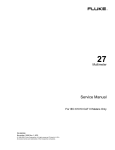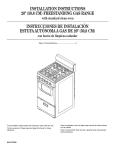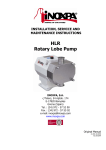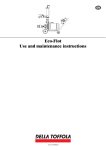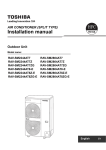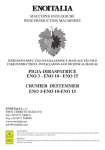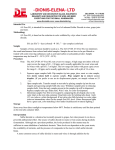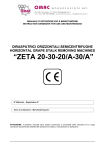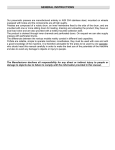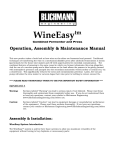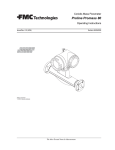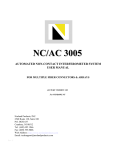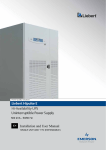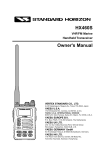Download Use and maintenance instructions for NDC 8
Transcript
EN Use and maintenance instructions for NDC 8-18 Destemmers-Crushers EN Read all the following safety recommendations very carefully before undertaking any action whatsoever with your machine. FIRST LEARN AND THEN ALWAYS FOLLOW ALL THE SAFETY RECOMMENDATIONS Read these safety recommendations very carefully before installing and using the machine. Also read all the explanatory and warning signs attached to the machine itself. Make sure that they are always easy to read, replacing any damaged or missing signs without delay. Read this manual carefully before using the machine to make sure that you are thoroughly familiar with how it works and all the controls. Never postpone learning this important information until you are already working with the machine. Never allow any unauthorized persons unfamiliar with the equipment to come into the vicinity or operate the machine. Always keep this manual readily available so that anyone taking action on the machine can refer to it. If the machine is sold or transferred to third parties, it is compulsory to hand over all the related technical documentation, use and maintenance EXPLANATION OF THE SYMBOLS Several symbols are used in this manual and on the machine itself to accompany hazard warnings and safety recommendations. These warnings and recommendations serve primarily to ensure the safety of Installers, Technicians and Operators, but also to avoid the machine being damaged. THIS SYMBOL IS USED TO DRAW YOUR ATTENTION TO THE RISK OF FATAL ACCIDENTS, SEVERE INJURIES AND EXTENSIVE DAMAGE IN THE EVENT OF THE SPECIFIED SAFETY MEASURES BEING DISREGARDED. THIS SYMBOL DRAWS ATTENTION TO RISKS OF A GENERAL NATURE. THIS SYMBOL IS USED TO DRAW YOUR ATTENTION TO THE RISK OF FATAL ACCIDENTS, SEVERE INJURIES AND EXTENSIVE DAMAGE IN THE EVENT OF THE SPECIFIED SAFETY MEASURES BEING DISREGARDED. THIS SYMBOL DRAWS ATTENTION TO RISKS DERIVING FROM THE PRESENCE AND USE OF ELECTRICITY. IMPORTANT This word is used to identify paragraphs in the manual containing essential information concerning the machine. Read the related information DEFINITIONS The following are definitions of the individual and legal entities involved in handling and using the machine. OWNWER: In this user manual, the OWNER is the legal representative of the company or body, or the individual, that purchased the machine. The Owner is responsible for ensuring compliance with all the safety requirements specified in the present manual and in the current legislation in the country where the machine is installed. This last aspect is waived if the Owner appoints a plant MANAGER, who thus takes responsibility for implementing the safety recommendations and for compliance with the safety standards relating to the use of the machine and relations with the OPERATOR. INSTALLER: In this user manual, the INSTALLER is the legal representative of the company appointed by the OWNER to install and connect the machine to the hydraulic, electrical and compressed air supply networks (etc.) at the plant. The Installer is responsible for correctly handling and installing the machine in compliance with the recommendations of this manual and with the current legal requirements in the country where the machine is used. OPERATOR: In this user manual, the OPERATOR is the person authorized by the OWNER or MANAGER to take all action on the machine for its usage, adjustment, control and routine servicing, as detailed in this manual (with which Operators must strictly comply, limiting their action to the explicitly allowable procedures). TECHNICIAN: In this user manual, the TECHNICIAN is the person directly authorized by the Manufacturer or, failing this (and entirely under the latter's responsibility), by the Manufacturer's Dealer in the various European Community states outside Italy, to carry out all extraordinary servicing procedures, as well as any adjustments, tests, repairs and replacements of parts proving necessary during the working life of the machine. GENERAL SAFETY RECOMMENDATIONS ! In unloading the machine on arrival, lifting and positioning it at the workplace, and all other handling procedures, comply scrupulously with the recommendations of the relevant section of this manual. Pay particular attention when handling wheel-mounted machines, which have to be moved by hand once they are on the ground. To prevent any risk of crushing, only move the machine by pushing it, never by pulling it, so that nobody can ever come to be in the path of the machine as it moves. Anyone handling the machine must be supervised by another person uninvolved in the procedure, who shall keep a constant watch to ensure that no obstacles or persons get in the machine's way and no other hazardous situations occur. This supervisor must promptly alert the person moving the machine of any hazards so that the machine can be stopped immediately. ! The surface on which the machine slides, like the surface on which it is used, must meet all the essential safety requirements: it must be perfectly horizontal and smooth, with nothing to interfere with the machine's movements. Check in advance to ensure that the whole distance to cover with the machine meets all the above-mentioned requirements. Make sure that the sliding and supporting surfaces have a load-bearing capacity sufficient to withstand the weight of the machine both empty and in use. Any discontinuity in the floor, e.g. expansion joints, grids and manholes, must meet the specified requirements. ! ! ! Never, for any reason whatsoever, lift the machine by any hoisting points other than those indicated. Before the machine is used, it must always be immobilized using the fixing devices provided. The machine must be placed in an area accessible only to the OPERATORS and TECHNICIANS; failing this, it must be protected by a barrier situated at least 2 m away from its outer edge. OPERATORS and TECHNICIANS may access the area where the machine is used providing they are adequately clothed and equipped with the personal protective equipment specified by law (safety shoes, gloves, helmet, etc.). The INSTALLER's personnel, or any visitors, must always be accompanied by an OPERATOR. Unauthorized personnel must never be allowed to remain alone in the vicinity of the machine. The place of installation must be made inaccessible to children. ! OPERATORS shall restrict themselves to taking action on the machine's controls, so they must not open any of the panels, except for the one for accessing the controls (if any). ! The INSTALLER shall restrict himself to taking action on the connections between the plant and the machine, so he must not open any panels, or operate any controls. ! In all handling, usage, servicing or repairs on the machine, it is compulsory to comply with all current safety standards in the country where the machine is used. This applies both to the equipment and to the operating methods adopted. ! Always disconnect the electric power supply before taking any action to install, service, repair or move the machine. This is of fundamental importance to prevent the risk of death, severe injury and extensive damage to the plant. ! In certain stages of normal use, some of the containers comprising the machine are under pressure (e.g. the filter vessel, plenum chamber, erosion-type dosing units, etc.). Never open such containers or remove any components connected to them before you have completely vented said pressure. Venting must be done through the valves provided on the machine specifically for this purpose. ! ! ! ! ! ! ! ! ! ! ! ! ! ! ! Never move the machine during normal working cycles. Before each new working cycle, make sure that any mobile electric connections (power cords, plugs, etc.) are sound and efficient. If they show any signs of damage, repairs must be made only by a specialized TECHNICIAN. Never take any action not mentioned in this manual under your own initiative. Connect the machine to the mains electric power supply according to the recommendations of this manual. Before starting the machine, check the efficiency of the earthing for the electric circuitry and machine frame or structure. Never use power cords of inadequate cross-section or provisional connections, not even briefly, and certainly not in the event of an emergency. Start the machine only after you have made sure of its perfectly safe connection to the systems providing the energy and anything else it needs to function properly (mains electricity and water, compressed gas supply, water drainage network, etc.). Keep a safe distance from any mechanical parts in motion. Immediately report any alarms or the tripping of any automatic machine safety devices to the TECHNICIAN. Never manually reset the machine after an alarm or an automatic safety device has been tripped without first identifying and dealing with the problem that caused them. Never remove the guards over moving parts while the machine is in operation. Before starting the machine, make sure all guards are correctly installed. Routinely perform all the scheduled servicing operations. Dispose of the packaging material for the machine at a suitable landfill, taking particular care over any film and plastic bags, which can expose children to the risk of suffocation. Never release the processing waste deriving from the working process directly into the environment. REGULATIONS FOR USING THE MACHINE IN THE FOODSTUFFS SECTOR The following considerations apply only to machines used with foodstuffs, i.e. destined to come into contact with products for human consumption: The machine in your possession has been designed and built to make it suitable for contact with foodstuffs, and fluids in particular. If in doubt about the intended uses of your machine, refer to the relevant chapter in this manual. ! ! For logistic reasons related to the phases prior to its use (e.g. transport to the user's premises, storage in warehouses, etc.), it is impossible to guarantee the delivery of the machine in conditions suitable to enable its immediate use without an accurate, preliminary sanitization. This is the responsibility of the end user, who may have to comply with any established protocols, e.g. HACCP. DEMOLITION AND DISPOSAL OF THE MACHINE ! At the end of its working life, the machine must be demolished and disposed of. ! THE MACHINE MUST ONLY BE DEMOLISHED AND DISPOSED OF BY ADEQUATELY-TRAINED AND PROPERLY-EQUIPPED PERSONNEL IN COMPLIANCE WITH THE FOLLOWING PROCEDURE. ! 1. Divide the machine into its constituent parts, separating the materials it is made of: ! ! ! ! ! ! ! ! ! mechanical parts (reducers, pump bodies, etc.); metal parts (structure, piping, etc.) electrical parts; rubber parts; plastic and synthetic parts. 2. All resulting materials must be treated and disposed of in accordance with the legal requirements in the country where the machine is used. 3. All components contaminated by oil and oily residues must be considered as special waste and disposed of by authorized consortiums. The same applies to the lubricants that periodically have to be changed. 4. In the event of the machine being placed out of commission, even only temporarily, it must be stored in an area inaccessible to children. All circuit breakers and isolators must be segregated and disconnected. Make a thorough check and release any built-up residual energy, e.g. liquids or gases under pressure inside containers or piping. The machine must also be checked from the static standpoint, to eliminate the risk of any single machine parts moving unexpectedly. THE MANUFACTURER ACCEPTS NO LIABILITY FOR DAMAGE TO PERSONS OR PROPERTY DUE TO THE RE-USE OF SINGLE MACHINE PARTS FOR ANY OTHER THAN THE ORIGINAL PURPOSES OR IN OTHER ASSEMBLY CONDITIONS. INSPECTION OF THE GOODS ON RECEIPT When it is delivered, the machine must be checked by the Customer to identify any signs of damage that it may have suffered in transit and ensure that the machine is complete in every part, as listed on the order form. If there are signs of damage, make an immediate note of the anomalies detected on the transport document (delivery note or CMR), adding the wording “RECEIVED WITH RESERVE DUE TO EVIDENT DAMAGE TO THE MACHINE”. Delivery ex works includes insurance coverage for any damage in accordance with the Italian law 450 of 22.08.1985 "Compensation limit". In the event of complaints, the Customer must be able to produce an adequate photographic documentation of the most obvious damage. GUARANTEE The Manufacturer guarantees the machine for the period indicated in the order form. The GUARANTEE consists exclusively in the replacement or repair, free of charge, of any parts acknowledged as being defective. The GUARANTEE does not cover electrical parts. The GUARANTEE is valid only if all installation and usage instructions have been followed (not only those stated by the Manufacturer, but also those suggested by current practice). The GUARANTEE becomes null and void in the event of any servicing procedures being undertaken by personnel not authorized by the Manufacturer. If the machine alarm sounds or one of the automatic safety devices is tripped, the machine must not be reset manually until the cause of the shutdown has been dealt with. Repeated manual resets can be sufficient reason for the Guarantee to become null and void. The GUARANTEE is valid providing any flaws or defects are reported within eight days of their detection; moreover, the GUARANTEE takes effect providing the use of the machine was suspended immediately after the fault was discovered. AFTER-SALES ASSISTANCE When requesting any information, servicing, or other services, it is essential to specify the SERIAL NUMBER of your machine. It is impossible to provide accurate instructions or schedule servicing measures unless this information is provided. RECOMMENDATIONS FOR PROTECTION AGAINST FREEZING If there is a danger of the ambient temperature dropping to 0°C / 32°F, be sure to empty any liquids (water or product to treat) from all of the machine's hydraulic circuits to prevent ice forming in the piping and damaging parts of the machine. NOTES ........................................................................................................................................................................................................................................ ........................................................................................................................................................................................................................................ ........................................................................................................................................................................................................................................ ........................................................................................................................................................................................................................................ ........................................................................................................................................................................................................................................ ........................................................................................................................................................................................................................................ ........................................................................................................................................................................................................................................ ........................................................................................................................................................................................................................................ ........................................................................................................................................................................................................................................ ........................................................................................................................................................................................................................................ ........................................................................................................................................................................................................................................ ........................................................................................................................................................................................................................................ ........................................................................................................................................................................................................................................ ........................................................................................................................................................................................................................................ ........................................................................................................................................................................................................................................ ........................................................................................................................................................................................................................................ ........................................................................................................................................................................................................................................ ........................................................................................................................................................................................................................................ ........................................................................................................................................................................................................................................ ........................................................................................................................................................................................................................................ ........................................................................................................................................................................................................................................ ........................................................................................................................................................................................................................................ ........................................................................................................................................................................................................................................ Contents 1. General information ..................................................................................................................3 1.1 1.2 1.3 1.4 1.5 1.6 1.7 1.8 1.9 1.10 2. Foreword ............................................................................................................................................. 3 How to read the manual ...................................................................................................................... 4 Type of marking.................................................................................................................................. 5 Intended use ........................................................................................................................................ 5 Misuse ................................................................................................................................................. 5 Identification of the machine .............................................................................................................. 5 Special recommendations ................................................................................................................... 6 General description ............................................................................................................................. 6 Technical features ............................................................................................................................... 8 Noise................................................................................................................................................ 8 Safety ...........................................................................................................................................9 2.1 2.2 2.3 2.4 2.5 2.6 2.7 3. Foreword ............................................................................................................................................. 9 Definitions........................................................................................................................................... 9 General safety rules........................................................................................................................... 10 Safety signs ....................................................................................................................................... 11 Description of residual risks ............................................................................................................. 12 Safety devices ................................................................................................................................... 15 Checking the efficiency of the safety devices................................................................................... 16 Installation ................................................................................................................................17 3.1 3.2 3.3 3.4 3.5 4. Lifting and handling the machine ..................................................................................................... 17 Space for working around the machine and for its integration in the production line ...................... 18 Electric wiring................................................................................................................................... 18 Checking the phase balance .............................................................................................................. 19 Characteristics of the pump for collecting the crushed grapes.......................................................... 19 Use .............................................................................................................................................20 4.1 4.2 4.3 4.4 4.5 4.6 4.7 4.8 5. Preliminaries and commissioning ..................................................................................................... 20 Operation........................................................................................................................................... 21 “Destemming and crushing” operating mode ................................................................................... 22 “Destemming alone ” operating mode .............................................................................................. 24 “Crushing alone” operating mode..................................................................................................... 25 Washing the destemmer-crusher....................................................................................................... 27 Routine stoppage............................................................................................................................... 28 Lengthy stoppages ............................................................................................................................ 28 Scheduled maintenance ...........................................................................................................29 5.1 5.2 5.3 5.4 5.5 6. Foreword ........................................................................................................................................... 29 General safety requirements.............................................................................................................. 29 Safety measures ................................................................................................................................ 29 Scheduled maintenance plan............................................................................................................. 30 Description of the servicing procedures............................................................................................ 30 Troubleshooting .......................................................................................................................31 6.1 6.2 The machine stops............................................................................................................................. 31 Unwanted vibrations ......................................................................................................................... 31 7. Key to NDC 8-18 destemmer-crusher components...............................................................32 8. Table of signatures ...................................................................................................................33 Position of the labels ........................................................................................................................34 NDC8-18_0307R01GB 1 This manual is the property of Della Toffola S.p.A. No part of this publication may be reproduced, circulated, translated into any language, transmitted or copied in any form or by any means, electronic, mechanical, photocopying, recording or otherwise, without prior permission from Della Toffola S.p.A. © All rights reserved. ENQUIRIES AND FURTHER INFORMATION: For any enquiries or further information concerning the use of the machine or the contents of this manual, or for any technical support, please contact the Della Toffola S.p.A. Customer Support Service, using the following references: Della Toffola S.p.A. – Servizio Assistenza Via Feltrina 72 - 31040, Signoressa di Trevignano (TV) (Italia) Tel.: +39 0423 6772 Fax: +39 0423 670841 PRESERVATION: Always keep a copy of this manual near the machine and readily available to the user, and store a spare copy in a safe place. If the manual is lost or damaged, contact Della Toffola S.p.A. for a replacement. This manual reflects the state of the machine as at the time when it was developed. Bear in mind that, in accordance with current legislation, this instructions manual forms an integral part of the machine and must accompany the machine at all times. DOCUMENT ID: Title File code Rev. N.: 2 Use and maintenance instructions for NDC 8-18 Destemmer-Crushers NDC8-18_0307R01GB.doc 01 – 07.07 NDC8-18_0307R01GB 1. General information 1.1 Foreword The NDC destemmer-crusher has been designed and manufactured to ensure a top-quality destemming and crushing action but at the same time it is very easy to use and highly reliable, assuring maximum operator safety. This last condition has been suitably verified by Della Toffola S.p.A., who can consequently guarantee its total compliance with CE safety standards. For proper accident prevention, it is only necessary to ensure its proper use and preventive maintenance in accordance with the recommendations contained in this manual. It is therefore worth stressing the following points right from the start: ² ² any action whatsoever that is taken on the machine must be subject to a prior, careful reading of every part of this manual, and particularly section 2 “SAFETY”. it is of fundamental importance and consequently compulsory for the machine to be used in compliance with the methods and for the intended uses stated in this manual; Della Toffola S.p.A. cannot be held liable for any faults, problems or accidents deriving from failure to comply with this requirement. This document has been designed to provide the maximum support for the personnel involved in the installation, use and maintenance of the machine, from when it is commissioned right up until it is disposed of. The responsibilities for the assembly, dismantling, set-up, use and maintenance of the machine must be clearly defined and respected; reference should be made to the “Users” and “Mechanical and electrical servicing technicians” tables in section 8 (“Table of signatures”), which must be completed with the signatures of the parties concerned to confirm that they have read and approved of the contents of these instructions. It is also emphasized that the proper installation, use and maintenance of the destemmer-crusher and the monitoring of the product fed into and delivered by the machine are fundamental to ensuring that your needs are met and that you achieve the best possible performance. NDC8-18_0307R01GB 3 1.2 How to read the manual This document has been prepared specifically to enable the owner's personnel to use the NDC destemmer-crusher easily and safely. The following symbol is used to emphasize requirements that are fundamental to personal safety: You are consequently advised to pay particular attention when reading these parts of the manual. A numerical reference is often provided in the text to indicate parts illustrated in the drawing in section 7: it is best to keep the page open so that the drawing is always visible for the reader to refer to. 4 NDC8-18_0307R01GB 1.3 Type of marking The NDC destemmer-crusher has to be considered as an integral part of a processing line, or "set of machines" in the sense used by the directive 98/37/CE, art. 2, clause a) second paragraph), so provision has to be made for its integration with adequate systems (not part of the supply) for loading the grapes, disposing of the stems and collecting the crushed grape product. That is why the machine must be intended as being "for incorporation" and is consequently declared compliant with the "manufacturer's declaration" in accordance with Appendix II, clause b) of the directive 98/37/CE. 1.4 Intended use The NDC destemmer-crusher has been designed and manufactured exclusively for destemming and crushing whole grapes harvested either by hand or by mechanical means. It is intended exclusively for use by suitably trained and qualified personnel who have been thoroughly informed about the use of its component parts and the conduction of the working cycle, as dictated by Della Toffola S.p.A. 1.5 Misuse Since the machine has been designed to assure safety in its normal or reasonably predictable use, pay careful attention to the following requirements: - any uses other than the one for which the machine was designed (as described in the previous paragraph "Intended use") is strictly forbidden; - the use of parameters other than those specified in the paragraph “Checking the phase balance” on page 18 cannot guarantee an adequate safety and reliability and is consequently strictly forbidden. 1.6 Identification of the machine The machine is identified by means of a nameplate located as illustrated in the figure. The nameplate must be kept intact and visible because it specifies the main characteristics of the machine, i.e. - manufacturer's name and address (a); - name of the machine (b); - serial number (c); NDC8-18_0307R01GB 5 - year of manufacture (d); - weight (e) 1.7 Special recommendations Given the numerous variables that can affect the destemming and crushing process, it is extremely difficult to provide unequivocal recommendations on the best way to handle the various procedures. However, once you have gained a little experience with the use of the machine, its great potential for meeting your every need with a variety of products will soon become self-evident. This manual contains the instructions for the standard version of the machine and it may be that the machine in your possession does not include certain components illustrated here, or said components may be arranged differently from those illustrated, without this affecting the efficiency and performance of your machine in any way. 1.8 General description The destemmer-crusher comprises a loading hopper (1) that receives the grapes and conveys them to the grape separating and destemming unit. A perforated drum (2) installed inside this unit contains a revolving beater bar (3). The drum rotates in the same direction as the beater bar, but at a lower speed so that the grapes can be gently and smoothly separated from the stalks. The destemmed grapes then pass through the holes in the drum into the crusher unit below (4), which comprises two star-shaped rollers made of non-toxic rubber (see Figure 1); the crushed grape product is then conveyed through collection tanks or by means of pumps (available on request) to the next processing stage. All metal components are made of stainless steel to ensure a long working life and corrosion resistance, and to provide a surface suitable for contact with foodstuffs. 6 NDC8-18_0307R01GB Inlet for grapes to destem Beater bar Perforated drum Grapes to crush Outlet for stalks Crushing rollers Grapes to crush Perforated drum Beater bar Crushing rollers Figure 1 Depending on the buyer's needs, the following optional devices can be installed: NDC8-18_0307R01GB - a plastic perforated drum - a beater bar with rubber blades - an automatic washing device - adaptation for 50 or 60 Hz power supplies. 7 1.9 Technical features Technical data Model NDC 8 NDC 18 Output t/h 6/10 13/18 Installed power kW 1.5 3 Length A* mm 2200 2500 Height B* mm 1500 1620 Height C* mm 370 500 Height D* mm 740 890 Width E* mm 850 950 Width F* mm 1550 1650 Kg 350 400 Weight AISI 304 Main structural material * maximum overall dimensions 1.10 Noise Machine operating conditions during the measurement Equivalent continuous A-weighted sound pressure level for NDC 8 Equivalent continuous A-weighted sound pressure level for NDC 18 8 Machine off (to measure background noise) Machine on and performing a typical working cycle Microphone position Leq(A) (dBA) Work station 80.0 Microphone position Leq(A) (dBA) Work station 81.0 NDC8-18_0307R01GB 2. Safety 2.1 Foreword Job safety is one of the main concerns of Della Toffola's designers. In the manufacture of this machine, every effort has been made to provide for all possible hazardous situations and, of course, to adopt suitable safety measures. Nonetheless, there are still some chances of accident deriving mainly from a careless or improper use of the machine. That is why it is essential to read this section very carefully before taking any action whatsoever to start the NDC destemmer-crusher, paying particular attention to the content of the section "Description of the residual risks". Carefully reading this manual and consequently making proper use of the machine are essential to its safe operation, otherwise Della Toffola S.p.A. can accept no liability for any accidents or damage. Likewise, the manufacturer accepts no liability for any changes made to the machine without prior written permission from Della Toffola S.p.A., since they may have a negative fallout on the CE marking and consequently make the corresponding manufacturer's declaration null and void. 2.2 Definitions In the design of this machine, the following definitions have been adopted, in accordance with section 1.1.1 of the directive 98/37/CE. • danger zone (marked by the dotted line in the following drawing): the whole machine footprint plus: - an outer band around its perimeter 1400 mm wide on the long sides and on the side where the grapes are fed into the hopper; - and outer band 1500 mm wide on the side where the stalks are unloaded. • operator: the person appointed to operate, control, adjust and service the machine; servicing technician: the person appointed to adjust, service and repair the machine; exposed person: any person coming within the danger zone for any reason during the completion of a working cycle. • • NDC8-18_0307R01GB 9 2.3 General safety rules The machine must not be used by any authorized persons. y It is forbidden for any persons under the influence of drugs, alcohol or medication influencing the speed of their reactions to assemble, commission, control, service or dismantle the machine. y The machine must be used only if it is in safe operating conditions. y Only use the machine for its intended purpose. Any other or improper uses cannot assure sufficient safety. y It is strictly forbidden for any outside or unauthorized personnel to come within the vicinity of the machine while it is operating. y It is forbidden for anyone to take independent action or to perform maneuvers other than those for which they have been authorized, or that may affect their own or other people's safety. y The efficiency of the emergency button must be checked every time the machine is started. y It is compulsory for the operator to deal with or report any damage or changes to parts of the machine that may have an influence in its safety without delay. y Never dismantle, modify or disable parts of the machine (functional parts, control systems or safety devices). y In the workplace, it is forbidden to use clothes or personal belongings that, given the nature of the process and the characteristics of the machine, might constitute a hazard for personal safety. Personal clothing worn at the workplace must consequently have no loose parts that may be drawn in by any moving parts. y Never wear bracelets, necklaces or other objects that may be caught up in moving parts. y Always use clothing and personal protection devices as specified in this manual and in the safety standards adopted at the plant. y The personnel authorized to take action on the machine must use only the equipment provided and appropriate tools (in good working order) for any servicing work they undertake; the established methods must be scrupulously and constantly followed. y While at work, personnel must remain in the right position and always avoid exposing themselves to any risk. y Workstations must be kept clean and tidy; all waste of any kind must be placed in suitable containers. y It is forbidden to perform any operations not specified in this manual and without making the machine safe as specified in section 5.3. y The responsibilities for the assembly, dismantling and reassembly, commissioning and servicing of the machine must be clearly defined and scrupulously followed. y The use of compressed air to clean parts of the machine must be restricted to the cases established in the production cycle, scrupulously using the specified personal protection to prevent accidents. It is strictly forbidden to use compressed air to clean a person or their clothing. 10 NDC8-18_0307R01GB y Never aim jets of water at the electrical parts of the machine. y In the event of fire, use dry extinguishers to avoid spreading the flames further. y In the event of an emergency, every worker must contribute - according to their own abilities, experience and aptitude - with the people appointed to undertake fire prevention, fire-fighting, evacuation, safety and first aid measures. y Any work on the electrical equipment must be handled exclusively by a qualified electrician. 2.4 Safety signs Periodically check the condition of the safety signs and take action as necessary to replace them. The signs are illustrated and their meanings and positions are explained in the table below: Sign Message Position Danger IMPORTANT!! Live electrical parts: risk of electrocution In line with each live part (motor, control circuit casings, etc.) IMPORTANT!! Crushing and cutting risk due to exposed parts needing to be segregated In line with the three interface risk zones IMPORTANT!! Risk of crushing hands under the removable cover On the removable cover Prohibitory Do not remove covers Do not undertake maintenance with the machine in operation NDC8-18_0307R01GB In line with each safety device (fixed panels, removable covers, etc) In line with each established servicing point 11 Mandatory Identification of the lifting points for crucial parts In line with each lifting point Risk of crushing during towing Near the control panel 2.5 Description of residual risks This paragraph lists the residual risks, i.e. hazards for which risk-reducing efforts at the design and manufacturing stages have not been entirely effective. The description of the residual risks concerns the following elements: y the type of risk to which operators and any third parties are exposed while the machine is in operation; y the category of persons exposed to such a risk; y the main preventive measures to adopt to reduce the risk of accident; y the corresponding safety signs applied. The following recommendations for accident prevention must be integrated with all the general recommendations in this manual and with current safety and accident prevention laws and standards. Anyone failing to comply with these recommendations will be exposed to risks that can vary in severity from mild injury to death. Residual risk Crushing and cutting between the loading hopper elements 12 Persons exposed Preventive and safety measures Operators and third parties Integration of the machine with loading equipment and complete segregation of the areas providing access to the hopper. It is consequently forbidden to start the machine unless the line in which it has been incorporated has being declared compliant with the provisions of the directive 98/37/CE (by the buyer or by a third party appointed by the buyer). Signs on the machine NDC8-18_0307R01GB Crushing and cutting between the stalk unloading elements Crushing and cutting between the crushed grape product delivery elements Crushing of the lower limbs under the wheels or of the body up against fixed obstacles Crushing and cutting of the upper limbs under the cover when it is being closed Operators and third parties Integration of the machine with unloading equipment and complete segregation of the area providing access to the stalk unloading device. It is consequently forbidden to start the machine unless the line in which it has been incorporated has being declared compliant with the provisions of the directive 98/37/CE (by the buyer or by a third party appointed by the buyer). Integration of the machine with delivery equipment and complete segregation of the area giving access to the crushed grape product delivery means. It is consequently forbidden to start the machine unless the line in which it has been incorporated has being declared compliant with the provisions of the directive 98/37/CE (by the buyer or by a third party appointed by the buyer). Any displacement of the machine must be done by hand with the utmost care and at very low speed; it is forbidden to use a vehicle to tow the machine. When opening and closing the cover, the operator must pay the utmost attention and keep any other persons well clear. For the location of the hazardous points and the signs attached to the machine, refer to the following figures. NDC8-18_0307R01GB 13 ² Hazardous points: GRAPE LOADING HOPPER COVER STALK OUTLET CRUSHED GRAPE OUTLET ² Position of signs: On both long sides 14 NDC8-18_0307R01GB 2.6 Safety devices Emergency stop button The NDC destemmer-crusher is complete with a mushroom-head emergency stop button. Using the emergency button In the event of a severe malfunction during the normal operation of the machine, that could jeopardize the safety of any personnel or of the machine, the working cycle can be stopped instantly by pressing the emergency stop button. The efficiency of this emergency device must always be checked before starting to use the machine. Restoring the machine to normal operation after an emergency stoppage After dealing with the cause of the emergency, raise the mushroom-head pushbutton, then press the “START” button. NDC8-18_0307R01GB 15 Electric circuit breaker The start-stop device also serves as an electric circuit breaker. Interlock on removable cover The NDC destemmer-crusher is complete with an interlock on the removable cover: if this is opened, the machine stops. Fixed panels The NDC destemmer-crusher is complete with fixed panels that prevent any contact with the hazardous elements. Interlock on cover Fixed panels The parts of the machine protected by said fixed panels may be accessed only by the qualified maintenance technicians. The panels must be put back in place as soon as any servicing has been completed. 2.7 Checking the efficiency of the safety devices IMPORTANT: Testing the safety devices has a strong influence on safety, so this must be done with the utmost care. Checking the emergency stop device The efficiency of the mushroom-head pushbutton must be checked before starting to use the machine. When it is pressed, it must stop the machine's operation completely. Checking the interlock on the removable cover The efficiency of the interlock must be checked once a week: when it is opened, it must stop the machine's operation completely. 16 NDC8-18_0307R01GB 3. Installation Prior to delivery, these machines undergo stringent testing to ensure their proper operation in different working situations. IMPORTANT! As stated earlier, the safe and proper use of the destemmer-crusher demands its incorporation in a production line complete with a screw or belt conveyor for loading the grapes, plus a screw or belt conveyor for disposing of the stalks and a pump for collecting the crushed grape product. That is why the end user has to ensure the adequate safety of the assembly as a whole, as well as meeting all the requirements stated in the directive 98/37/CE (technical file, instructions on the use of the assembly, CE marking, CE declaration of conformity, etc.) BEFORE STARTING TO USE THE MACHINE. Della Toffola's technical support service is naturally available for any needs emerging in this context. 3.1 Lifting and handling the machine Before unloading the machine, make sure that the surface where it will stand has a load-bearing capacity capable of withstanding the weight of the machine itself (see the technical characteristics on page 8) and of the load of product being processed. To lift and transfer the machine, use a forklift with a carrying capacity suitable for the weight of the machine. Pay attention to ensure that the forks do not cause strain on any deformable parts or electric cables. The machine’s center of gravity is off-center, towards the side with the hopper, above the drive unit and roller bed. Make sure that the levers for locking the roller bed 12 are raised, then position the truck’s fork as illustrated in Figure 2. Once it has been set on the ground and the packaging has been removed, the machine is easy to move because it is mounted on wheels. After positioning the machine in the workplace, lock these wheels with the brakes provided. Figure 2 NDC8-18_0307R01GB 17 3.2 Space for working around the machine and for its integration in the production line Figure 3 shows the space needed to install the accessories for the NDC destemmer-crusher. Figure 3 A Area for installing the device for loading the grapes and for scheduled maintenance; B Area for operating and adjusting the crushing rollers, for installing the crushed grape product collection pump, and for operating the electric devices; C Area for operating the handle 5 for opening and closing the cover 6. Area for extracting the beater bar and for installing the stalk unloading device. 3.3 Electric wiring The destemmer-crusher requires a three-phase power supply. IMPORTANT! The connection to the mains, like all other ordinary and extraordinary action on the machine’s electric circuitry, must be done by a qualified technician. The mains power supply must be consistent with current standards (CEI etc.) and legal requirements. It is important to remember that it is compulsory to earth the machine. Never use cables of inadequate cross-section or provisional connections, not even for brief periods of time. It is also important to comply with all the safety standards concerning the rooms where the machine is installed. 1) The connection to the mains must be made using the power cord, complete with a plug, already fitted at the factory. 2) Before powering the machine, make sure that the voltage of the required for the machine coincides with that of the mains power supply available. 18 NDC8-18_0307R01GB 3.4 Checking the phase balance Do not operate the electric motors if the voltage unbalance between the phases is greater than 3%. Use the following formula to check the balance: max. voltage shift from mean % voltage unbalance = mean voltage X 100 A B C Example: rated mains voltage 400V 3 ~ 50 Hz AB = 409V BC = 398V AC = 396V mean voltage = 409 + 398 + 396 3 = 401V How to calculate the percentage of unbalance: % voltage unbalance = 409 – 401 401 x 100 = 1.99% This value is acceptable because it is less than the maximum allowable, i.e. 3%. IMPORTANT If the mains voltage has an unbalance greater than 3%, contact the Electricity Board. Operating the machine with a voltage unbalance between the phases greater than 3% makes the GUARANTEE NULL AND VOID. The mains power supply must coincide with the rated value ± 10% . 3.5 Characteristics of the pump for collecting the crushed grapes It is best for the pump used to collect the crushed grape product to have a capacity about 20-30% greater than the destemmer-crusher in order to avoid the risk of the product accumulating in the machine. It is also advisable to use vane or “Mohno” pumps, which are more suitable than piston pumps (the latter are frequently liable to clogging). NDC8-18_0307R01GB 19 4. Use IMPORTANT! The machine must only be used by personnel suitably trained and qualified to do so. Before starting the machine, make sure of its proper incorporation in the production line: the positioning of the screw or belt conveyor over the grape loading hopper 1, of the screw or belt conveyor for collecting and disposing of the stalks at the outlet 16 and of the pump for collecting the crushed grape product from under the crushing rollers 4 must guarantee the total inaccessibility of the previouslymentioned hazardous elements. It is important to emphasize here that it is FORBIDDEN TO START THE MACHINE BEFORE THE WHOLE LINE HAS BEEN DECLARED COMPLIANT WITH THE REQUIREMENTS OF THE DIRECTIVE 98/37/CE BY THE USER. Also make sure that all the panels and covers have been installed and closed properly and that the safety devices are operational. In the event of any anomalies, contact the Della Toffola S.p.A. customer support service. 4.1 Preliminaries and commissioning Before starting the destemmer-crusher, proceed with an accurate preliminary cleaning. The preliminary cleaning of the perforated drum and beater bar must be done simply by opening the cover 6 and using a normal jet of water. Take care to avoid aiming the jet of water at the motors and gearing; then make sure the panel 8 is closed properly. IMPORTANT! When manually cleaning the machine with liquids, it is essential to take the utmost care. Before aiming a jet of water at any part of the destemmer-crusher, it is essential to disconnect the electric power supply. After completing the preliminary cleaning, close the cover 6 and lock it with the aid of the handle 5 (see Figure 4); otherwise the machine will not work. IMPORTANT Pay great attention when you close the cover 6. The handle 5 must be completely extracted to avoid damaging the limit switch 17 (second picture in figure 4). 20 NDC8-18_0307R01GB EXTRACT THE HANDLE TO RELEASE THE SAFETY DEVICE PRESS IN THE HANDLE TO LOCK THE SAFETY DEVICE 5 6 Figure 4 Run the machine empty for a few minutes and make sure there are no anomalous noises and it is working properly. If not, contact the Della Toffola S.p.A. customer support service. 4.2 Operation Press the START button to start operating the machine. To stop the machine at any time, press the STOP/EMERGENCY STOP button (Figure 5) STOP/EMERGENCY STOP BUTTON POTENTIOMETER START Figure 5 The POTENTIOMETER is for adjusting the turning speed of the beater bar 3, as explained below. The NDC destemmer-crusher can be operated in three different ways: NDC8-18_0307R01GB - destemming and crushing; - destemming alone; - crushing alone. 21 Destemming and crushing The “destemming and crushing” operating mode is the one most suitable for the majority of the wine cellar’s purposes in processing white and/or red grapes. The other two operating modes, “destemming alone” and “crushing alone” are intended for very limited uses, almost exclusively involving white grapes that need special processing. Destemming alone This is a method that is used with particular white grapes, which are then sent immediately to the pneumatic pressing stage. Crushing alone This method is also used with certain types of white grape, which then go straight to the pneumatic pressing stage. The reason for retaining the stems in this case is to improve the drainability of the mass of crushed grapes, so as to facilitate and accelerate the outflow of the must. 4.3 “Destemming and crushing” operating mode In this operating mode, the destemmer-crusher first removes the grapes from the stems and then crushes the grapes between the rollers 4 (Figure 6). Figure 6 Depending on the type of grape and the type of destemming action needed, the turning rate of the beater bar 3 can be adjusted by means of the potentiometer (Figure 7). Before adjusting the potentiometer, you need to release it by means of the side lever, which must be returned to its locked position before getting back to work. Low turning speeds enable a gentle, good-quality destemming without particularly affecting the grapes, but this means a lower productivity; on the other hand, high turning speeds enable higher outputs but of lower quality. 22 NDC8-18_0307R01GB TURN CLOCKWISE TO INCREASE THE SPEED TURN ANTICLOCKWISE TO REDUCE THE SPEED Side lever Figure 7 You can adjust the crushing effect on the grapes using the device illustrated in Figure 9 (overleaf). DANGER Before making any adjustments IT IS ESSENTIAL TO DISCONNECT THE MAINS POWER SUPPLY TO AVOID THE RISK OF ACCIDENTAL STARTUPS. To make an adjustment, first you need to withdraw the crushing rollers 4 from the destemmer-crusher. To do so, go to area “B” (see section 3.2), release the levers 12 by turning them downwards, then pull the lever 13 hard towards you and turn the roller bed 4 outwards as far as it will go (Figure 8). Figure 8 Then tighten or loosen the hand wheels 11 (Figure 9/A) to increase or decrease the distance between the crushing rollers. Make the same adjustment on both hand wheels, checking with the two graduated scales provided (Figure 9/B). NDC8-18_0307R01GB 23 A B 11 11 Figure 9 After completing the adjustment, close the roller bed 4 once again, paying attention to ensure that the device 14 (Figure 8) is hooked up properly and the drive elements 10 are engaged; if necessary, correct the position of the gears by turning the lever 13. Finally, lock the crushing rollers in place with the aid of the levers 12 (Figure 8). 4.4 “Destemming alone ” operating mode In this operating mode, the grapes are only destemmed and sent directly to the next processing stage without passing through the roller bed 4 (Figure 10). Figure 10 To use this operating mode, simply disable the crushing rollers by withdrawing them from the destemmer-crusher. To do so, go to area “B” (see section 3.2), release the levers 12 by turning them downwards, then pull the lever 13 hard towards you and turn the roller bed 4 outwards as far as it will go (Figure 8). 24 NDC8-18_0307R01GB 4.5 “Crushing alone” operating mode In this operating mode, the grapes are crushed with their stems still attached (Figure 11). Figure 11 To use this operating mode, you need to remove the beater bar 3 and the perforated drum 2 from the destemmer-crusher. DANGER Before making any adjustments IT IS ESSENTIAL TO DISCONNECT THE MAINS POWER SUPPLY TO AVOID THE RISK OF ACCIDENTAL STARTUPS. Of course, even in the case of the additional operating modes described, it is essential to take action to completely segregate the danger zones BEFORE STARTING THE MACHINE, and then to proceed with the CE marking of the whole line. NDC8-18_0307R01GB 25 Extracting the beater bar and perforated drum. Release the cover 6 by means of the handle 5, as illustrated in Figure 4 and open the cover (Figure 12); TO OPEN THE COVER, RELEASE IT BY EXTRACTING THE HANDLE (Figure 4) AND TURN IT CLOCKWISE AS SHOWN IN Figure 12 Figure 12 Standing in the working area C (Figure 3), pull the beater bar 3 about 20 cm towards you so as to slide it away from the hopper gearing, then - with the aid of belts and a crane - tie up the beater bar on one side and the perforated drum on the other, as illustrated in Figure 13. Slowly lift the equipment, taking care to keep the perforated drum and beater bar as horizontal as possible. Figure 13 Finally, after removing the perforated drum and beater bar, close and lock the cover 6, paying attention to ensure that there are no exposed persons in the area where it closes (where a cutting/crushing risk consequently exists). 26 NDC8-18_0307R01GB 4.6 Washing the destemmer-crusher DANGER When manually cleaning the machine with the aid of a liquid, it is important to pay the utmost attention. Before aiming any jets of water at any part of the machine, it is essential to disconnect it from the mains power supply. During the normal use of the destemmer-crusher, it is advisable to clean the machine once a day. Should it prove necessary to wash it more often, you are strongly advised to install the automatic washing device (optional). To wash the destemmer-crusher, use a high-pressure jet of water, paying attention to avoid aiming it at the motors and drive elements; then make sure the panel 8 has been closed properly. To wash the perforated drum and beater bar, you have to open the cover 6 as illustrated in Figure 12. After completing the washing procedure, close the cover 6 making sure that there are no exposed persons in the area where it closes (where a cutting/crushing risk consequently exists). Run the destemmer-crusher for a few seconds to turn the perforated drum and beater bar. Then stop the machine, open the cover 6 and repeat the washing cycle with a jet of water. Proceed in this way 2 or 3 times, or as long as it takes to clean the machine thoroughly. Also clean the crushing rollers by removing them from the machine and removing the hopper roller bed, as illustrated in Figure 14. HOPPER ROLLER BED Figure 14 At the end of the working season, and before any prolonged stoppages, it is essential to wash the perforated drum and beater bar accurately using a highpressure jet of water and, where necessary, suitable tartrate removing substances. NDC8-18_0307R01GB 27 4.7 Routine stoppage It is of fundamental importance to remember that a normal stoppage of the machine is not sufficient for servicing purposes, for which it is essential to follow the procedure illustrated in section 5 “Maintenance". At the end of the working day, or when the machine must be left unattended, proceed as follows: y complete the working cycle. y press the stop button. 4.8 Lengthy stoppages If the machine is being stopped for a lengthy period of time, proceed as follows: y stop the machine in the normal way; y place the machine in conditions of safety (see section 5 “Maintenance”) y clean the machine of any dust and residue from the working process; y cover the machine with protective sheets. 28 NDC8-18_0307R01GB 5. Scheduled maintenance 5.1 Foreword The object of this section is to provide all the necessary information for the performance of the servicing activities that operators are allowed to conduct. For all operations not specifically mentioned in this section, contact Della Toffola S.p.A. for adequate assistance. 5.2 General safety requirements Bear in mind that any action whatsoever on the machine must be preceded by a careful reading of every part of this manual, paying particular attention to section 2 “SAFETY”, and must be handled by suitably trained and qualified personnel who have been thoroughly informed about potential predictable dangers. ² Moreover, any changes made to parts of the machine may make its CE marking null and void. 5.3 Safety measures Before taking any action to service the machine, it is essential to place the system in conditions of the utmost safety by taking the following steps: - complete any processing cycle underway and stop the system; cut off the electric power supply by pressing the emergency stop button. Extract the lever and attach a padlock, as shown in the figure; remove the keys and put them in a safe place. LEVER TO EXTRACT Disable all the correlated equipment that may interfere with the servicing of the destemmer-crusher. Place a notice with the wording "MAINTENANCE UNDERWAY, KEEP CLEAR!" on the control console. The servicing operations can now begin and must always be completed in conditions of utmost safety. NDC8-18_0307R01GB 29 5.4 Scheduled maintenance plan The following table shows the routine servicing that needs to be done at the specified intervals. Servicing interval ACTION Page ref. Daily Check safety devices 16 Check drive belts 30 Check perforated drum 30 Check beater bar 30 Wash machine 30 At the beginning of the working season At the end of the working season X X X X X X 5.5 Description of the servicing procedures Drive belts Check the drive belts situated under the panel 8. To do so, remove the panel by releasing the screws and make sure that the belts are taut and in perfect working order. Generally speaking, when they show signs of white patches and fraying, this means the belts are becoming worn and it is necessary to tighten them (call the Della Toffola customer care service and provide the details specified on page 2). Perforated drum and beater bar Remove the perforated drum and beater bar as explained on page 26 and make sure none of the component parts have been deformed or broken; if necessary, call the Della Toffola customer support and provide the details specified on page 2). Moreover, accurately wash all the dismantled machine parts and the machine itself with a normal jet of water. Washing the machine Do a preliminary machine washing cycle with a high-pressure water jet before using the machine, as explained on page 26. 30 NDC8-18_0307R01GB 6. Troubleshooting 6.1 The machine stops If any sizable foreign bodies accidentally get inside, the machine may seize. If any foreign bodies, e.g. pieces of wood, scissors, etc., accidentally get inside the hopper, press the EMERGENCY STOP button immediately. Before taking any action whatsoever, IT IS ALSO ESSENTIAL TO PLACE THE MACHINE IN SAFE CONDITIONS (see section 5.3) TO AVOID ACCIDENTAL STARTUPS. Open the cover 6 and take action to remove the foreign body, paying attention to avoid damaging the machine. Once you have removed the foreign body, release the emergency stop button and press START to restore the machine to normal operation. 6.2 Unwanted vibrations The roller bed 4 is fitted with a sprung safety device that enables the crushing rollers to be separated to allow for any foreign body accidentally inserted to be removed. Any passage of foreign bodies through the destemmer-crusher may cause permanent damage to the machine, even though it may continue to function. Any denting of the blades on the bar, for instance, will inevitably unbalance the bar. Check the destemmer-crusher regularly while it is in use: in the event of any unusual vibrations it is highly likely that some component has been damaged. Stop the machine immediately to check for any damage and call in the Della Toffola customer support service. The machine may be only used again after it has been restored to perfect efficiency and safe operating conditions. A) NDC8-18_0307R01GB 31 5 3 6 2 7 6 1 1 5 8 17 16 15 1) 2) 3) 4) 5) 6) 7) 8) 9) 4 11 14 13 11 12 4 12 11 10 GRAPE LOADING HOPPER PERFORATED DRUM BEATER BAR CRUSHING ROLLERS HANDLE FOR LOCKING SAFETY COVER 6 SAFETY COVER CONVEYOR WORM PANEL FOR PROTECTING MOTORS AND DRIVE ELEMENTS CASTOR WHEEL WITH BRAKE 9 10) 11) 12) 13) 14) 15) 16) 17) GEARS HANDWHEEL FOR ADJUSTING CRUSHING ROLLERS LEVERS FOR BLOCKING CRUSHING ROLLERS LEVER FOR WITHDRAWING CRUSHING ROLLERS DEVICE FOR HOOKING UP CRUSHING ROLLERS STRAIGHT WHEEL OUTLET FOR STEMS LIMIT SWITCH FOR LOCKING HANDLE 7. Key to NDC 8-18 destemmer-crusher components 32 8. Table of signatures The responsibilities for the assembly, dismantling, commissioning, use and servicing of the machine must be clearly defined and respected; the personnel responsible for the use and servicing of the machine must consequently add their name, date and signature to the table below to confirm that they have read and approved of the contents of these instructions. OPERATOR Surname and name Date Signature MAINTENANCE TECHNICIANS Surname and name Date Signature NDC8-18_0307R01GB 33 MOD. S/02-06 MOD. S/03-06 MOD. S/02-06 MOD. S/3-99 LO SPOSTAMENTO DELLA MACCHINA VA ESEGUITO A SPINTA CON LA MASSIMA CAUTELA: È VIETATO IL TRAINO CON VEICOLI THE MACHINE MUST ONLY BE MOVED BY PUSHING, TAKING THE UTMOST CARE. IT IS FORBIDDEN TO TOW THE MACHINE WITH A VEHICLE DIE MASCHINE DARF NUR DURCH VERSCHIEBEN DERSELBEN FORTBEWEGT WERDEN, WOBEI MIT GRÖSSTER VORSICHT VORZUGEHEN IST: DAS ZIEHEN DER MASCHINE UNTER ANWENDUNG VON FAHRZEUGEN IST STRIKT VERBOTEN LA MACHINE DOIT ÊTRE DÉPLACÉE PAR POUSSÉE AVEC BEAUCOUP DE PRÉCAUTION. TOUTE TRACTION À L'AIDE D'UN VÉHICULE EST INTERDITE LA MÁQUINA DEBE DESPLAZARSE POR EMPUJE CON EL MÁXIMO CUIDADO. PROHIBIDO EL REMOLQUE CON VEHÍCULOS OBBLIGO DI CALZATURE DI SICUREZZA IT IS COMPULSORY TO WEAR SAFETY SHOES ES IST SICHERHEITSSCHUHWERK ZU TRAGEN CHAUSSURES DE SÉCURITÉ OBLIGATOIRES OBLIGACIÓN DE USAR CALZADO DE SEGURIDAD S/02-05 MOD. S/04-06 MOD. S/02-06 MOD. S/03-06 MOD. S/02-06 MOD. S/02-05 MOD. S/04-06 Targhetta CE in acciaio Positioning of labels MOD. S/3-99 34 IT I dati contenuti in questa pubblicazione sono forniti a titolo indicativo ed espressi in forma sintetica. La Della Toffola S.p.A potrà apportarvi in qualunque momento eventuali modifiche motivate dalle normali pratiche di sviluppo tecnologico e commerciale, senza peraltro alterare le caratteristiche essenziali del prodotto. Le istruzioni vengono redatte in lingua Italiana e quindi tradotte nella lingua richiesta dal Cliente. Tali traduzioni vengono eseguite con la dovuta diligenza, e fornite poi al Cliente con le riserve di prassi. La Della Toffola S.p.A. non fornisce alcuna garanzia sulle traduzioni realizzate da essa stessa o per suo conto. Viene riconosciuta come ufficiale la versione aggiornata della pubblicazione in lingua Italiana. Per eventuali informazioni il Cliente può contattare la Rete di Assistenza o direttamente la Della Toffola S.p.A. © Della Toffola S.p.A. - Tutti i diritti sono riservati EN The information contained in this publication is provided for use solely as a guideline, and is intended as a brief summary. Della Toffola S.p.A. may make changes at any time based on normal technological and commercial development, without thereby altering the essential features of the product. The instructions are originally written in Italia and then translated into the language requested by the customer. These translations are carried out with due diligence and supplied to the customer with all due reservations. Della Toffola S.p.A. does not offer any guarantee on the translations performed in-house or on its behalf. The updated version of the publication in Italian shall be considered the official document. For any further information, the customer may contact the Service network or Della Toffola S.p.A. Directly. © Della Toffola S.p.A. - All rights reserved DE Die in der vorliegenden Veröffentlichung enthaltenen Daten sind unverbindlich und in gekürzter Form wiedergegeben. Die Firma Della Toffola S.p.A. behält sich das Recht vor, diese Daten jederzeit im Zuge der technischen Weiterentwicklung oder aus kommerziellen Gründen zu modifizieren, ohne allerdings die wesentlichen Eigenschaften des Produkts zu verändern. Die Anleitungen werden in italienischer Sprache verfaßt und anschließend in die vom Kunden gewünschte Sprache übersetzt. Diese Übersetzungen werden mit der gebührenden Sorgfalt ausgeführt und dem Kunden mit den üblichen Vorbehalten zur Verfügung gestellt. Die Firma Della Toffola S.p.A. haftet nicht für die im eigenen Haus oder in ihrem Auftrag ausgeführten Übersetzungen. Offizielle Gültigkeit hat die überarbeitete Version der Veröffentlichung in italienischer Sprache. Für weitere Informationen wenden Sie sich bitte an eine Kundendienststelle oder direkt an Della Toffola S.p.A. © Della Toffola S.p.A. - Alle Rechte vorbehalten. FR Les données figurant dans cette publication sont fournies à titre indicatif et exprimé es en forme synthétique. Della Toffola S.p.A. pourra en tout moment apporter des modifications éventuelles suite au développement technologique et commercial, sans pour cela altérer les caractéristiques essentielles du produit. Les instructions sont rédigées en langue italienne et ensuite traduites dans la langue demandée par le Client. Les traductions sont effectuées avec diligence et fournies au Client sous toutes réserves. Della Toffola S.p.A. ne fournit aucune garantie sur les traductions effectuées à son intérieur ou pour son compte. La version mise à jour de la publication en langue italienne est considérée la version officielle. Pour tout renseignement, le Client peut contacter le Réseau de Service après-vente ou directement la société Della Toffola S.p.A. © Della Toffola S.p.A. - Tous droits réservés. ES Los datos contenidos en esta publicación son sólo indicativos y están expresados de una forma sintética, Della Toffola S.p.A. podrá modificarlos en cualquier momento, debido a normales prácticas de desarrollo tecnológico y comercial, sin que ello altere las características esenciales del producto. Las instrucciones se redactan en italiano y luego se traducen al idioma pedido por el Cliente. Las traducciones se efectúan con el máximo esmero, pero son entregadas al Cliente con las normales reservas de estos casos. Della Toffola S.p.A. no presta ninguna garantía sobre las traducciones realizadas por la empresa misma o por su cuenta. Se reconoce como oficial la versión actualizada de la publicación en italiano. Para más información, el Cliente puede dirigirse a la Red de Asistencia o directamente a Della Toffola S.pA. © Della Toffola S.p.A. - Reservados todos los derechos N° di Matricola - Serial Number Seriennummer - N° de Matricule N° de Matrícula SERVIZIO ASSISTENZA Per qualunque richiesta di informazioni, interventi etc. è sempre necessario comunicare il NUMERO DI MATRICOLA della macchina. Non è possibile fornire istruzioni precise o programmare interventi senza che sia fornito questo dato. Il numero di matricola è anche stampigliato su una apposita targhetta fissata sulla macchina. ASSISTANCE SERVICE For any request regarding information, service, etc., it is always necessary to indicate the SERIAL NUMBER of the machine. It is not possible to provide precise instructions or schedule servicing unless this information is communicated. The serial number is printed on the plate fixed to the machine, too. KUNDENDIENST Bei allen Anfragen um Informationen, Eingriffe usw. stets die SERIENNUMMER der Maschine angeben. Ohne diese Angabe können keine exakten Informationen geliefert und keine Eingriffe geplant werden. Die Seriennummer ist auch dem Typenschild auf der Maschine zu entnehmen. SERVICE ASSISTANCE Pour toute demande d'informations, d'interventions, etc., il faut toujours indiquer le NUMERO DE MATRICULE de la machine. Il est impossible de fournir des instructions précises ou de programmer des interventions sans cette donnée. Le numéro de matricule est estampillé aussi sur la plaquette fixée sur la machine. SERVICIO DE ASISTENCIA Para cualquier solicitud de información, de intervenciones u otros servicios, indicar siempre el NÚMERO DE MATRÍCULA de la máquina. Es imposible suministrar indicaciones precisas o programar intervenciones sin este dato. El número de matrícula se encuentra impreso también en una placa especial aplicada a la máquina. DELLA TOFFOLA S.p.A. Via Feltrina, 72 31040 SIGNORESSA DI TREVIGNANO (TREVISO) ITALY 800-803276 Tel. +39 0423 6772 Internet: www.dellatoffola.it e-mail: [email protected] Fax +39 0423 670 841 Direzione - Uffici Commerciali Ufficio Amministrazione +39 0423 679 196 Ufficio Tecnico +39 0423 670 491 Ufficio Acquisti


















































